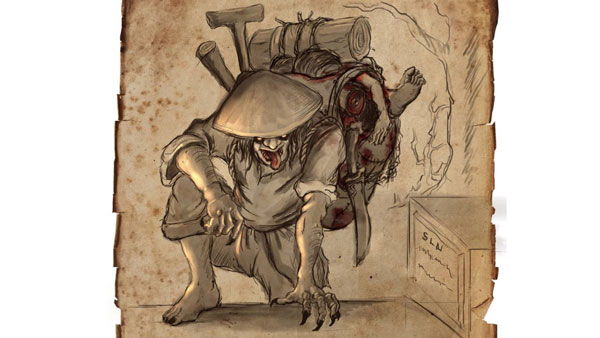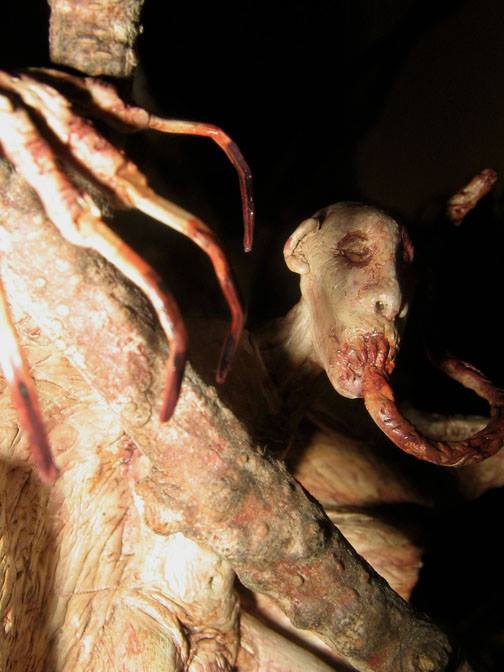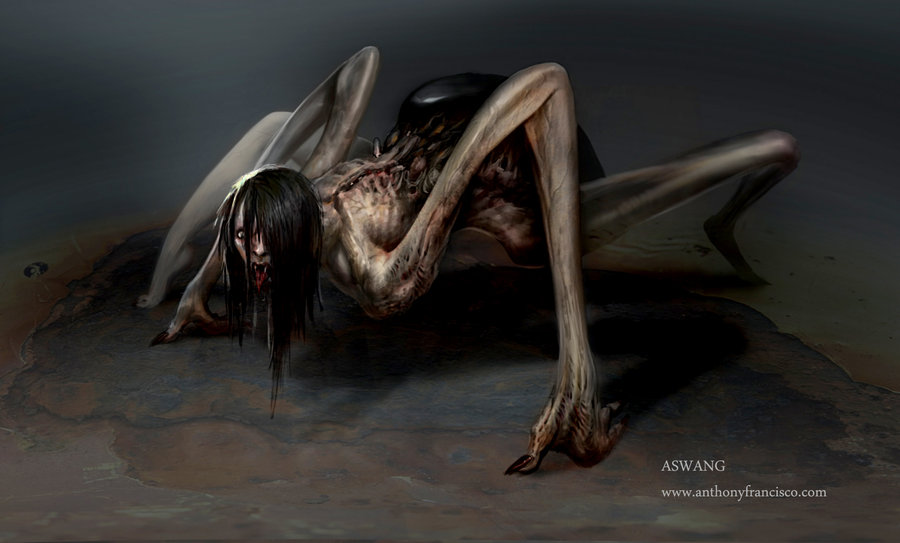Within the pantheons of Philippine Mythology, it isn’t enough to be terrified by creatures that will cause your death and devour your flesh. Nope, you must also worry about what will happen after your untimely demise. Enter, the BAL-BAL – perhaps the most gruesome of the Philippine corpse thieves.

Stories say the Bal-Bal is a creature who steals corpses to feed on the rotting flesh – using sharp claws and teeth for tearing through muscle and bone. Once the Bal Bal has fed, it will leave the trunk of a banana tree in the coffin, creating an illusion of the stolen body.
The physical attributes of the Bal-Bal have been adopted into many other tales of flesh eating creatures throughout the Philippines – such as the Visayan version of the Aswang, the Amalanhig, and the Busaw. Modern tales of the Bal-Bal say he walks in regular human form until drenched by the light of the full moon, where he will shape-shift into a disfigured bone collector. Other stories say if you utter his name “Bal-Bal” (I do not recommended trying this at home), he will seek you out and devour your flesh.
In The Creatures of Philippine Lower Mythology, Dr. Maximo Ramos credited tales of the Bal-Bal back to the Tagbanua people. The Tagbanua are mainly found in the central and northern regions of Palawan. Research has shown that the Tagbanua are possible descendants of the Tabon Man; thus, making them one of the original inhabitants of the Philippines – dating back an estimated 40,000 years. The many ceremonial feasts punctuating Tagbanua life are based on a firm belief in a natural interaction between the world of the living the world of the dead.
Dean C. Worcester (Philippine Islands) wrote a vivid description of the balbal which the Tagbanua believe in:
“While a corpse is awaiting burial, the Tagbanua are in dread of a mythical creature called balbal, which they say comes from the Moro country. It sails through the air like a flying squirrel. In form it is manlike, with curved nails which it uses to tear up the thatch houses, and a long tongue with which it reaches down to “lick up” the bodies”

Other Corpse Thieves in Philippine Beliefs:
The Cuyonon believe that the ghouls steal corpses from under the very noses of the mourners by invisibly substituting a banana trunk for it, the latter then becoming indistinguishable from the corpse except that the stalk “has no fingerprints.”
The Bikol asuwang na lakaw, or ‘walking aswang’ , “. . . decides, about 6 p.m., where he or she operates that night by putting his ear to the rice mortar and listening to sounds of mourners, or listens for such sounds while standing on his head, resting in a shallow hole in the ground, or, say others, removing the cover of a specially made listening well and listening. At 8 o’clock he leaves for his operations.”
Also from Bicolano folklore, an Aswang that could smell if a person is terminally ill is known as an Anduduno. It prowls outside or under the house of the victim and uses its very long, snake-like tongue to lick the sick person until the victim dies. Sometimes it waits outside the house of a dying person. Once that person dies and has been buried, it digs up and eats the corpse.
Aswang Na Lipad from the Eastern Visayas is distinct from other flying Aswangs because it keeps its human form and does not need wings to fly. After taking its clothes off, it applies under its armpits a green ointment made of herbs and fat, before rising into the night. It rides the current, as though swimming on its back, in search of a fresh corpse. Finding one, it takes only the liver and swiftly departs. It is never known to feed on living men, although reported cases of dead farm animals with missing livers have been blamed on the Aswang na Lipad. Citrus fruits take away its ability to fly.
The Berbalangs are from Cagayan, Sulu and have a human appearance, but resemble the characters of vampires and have wings and slanted eyes. They dig up graves to feast on the corpses.
The following account of an encounter with the Berbalangs occurs in Rupert T. Gould’s book Oddities, published in 1928:
“At the center of the island is a small village, the inhabitants of which owe allegiance to neither of the two chiefs. These people are called ‘Berbalangs’, and the Cagayans live in great fear of them. These Berbalangs are a kind of ghouls, and feed on human flesh occasionally to survive. You can always identify them, because the pupils of their eyes are not round, but just narrow slits like those of a cat. They dig open the graves and eat the entrails of the corpses; but in Cagayan the supply is limited. So when they feel the craving for a feed of human flesh they go away into the grasslands, and, having carefully hidden themselves, hold their breaths and fall into a trance. Their astral bodies are then liberated…. They fly away, and entering a house make their way into the body of one of the occupants and feed on their entrails….. The arrival of the Berbalangs may be heard from afar, as they make a moaning noise which is loud from a distance but dies away into a feeble moan as they approach. When they are near you the sound of their wings may be heard and the flashing lights of their eyes can be seen like dancing fire-flies in the dark. Should you be the happy possessor of a cocoa-nut pearl you are safe, but otherwise the only way to beat them off is to jab at them with a kris, the blade of which has been rubbed with the juice of a lime. If you see the lights and hear the moaning in front of you, wheel fast and make a cut in the opposite direction. Berbalangs always go by contraries and are never where they appear to be.
The cocoa-nut pearl, a stone like an opal sometimes found in the cocoa-nut, is the only really efficacious charm against their attacks; and it is only of value to the finder, as its magic powers cease when it is given away. When the finder dies the pearl loses its luster and becomes dead. The juice of limes sprinkled on a grave will prevent the Berbalangs from entering it, so all the dead are buried either under or near the houses, and the graves are sprinkled daily with fresh lime juice.”
On Romblon, the Kagkag are a race of ghouls that comes out at moonrise and moonset. They listen for the sounds of other ghouls, then follow them to find freshly buried corpses. Once a cadaver has been found, they place it over a large banana leaf and proceed to celebrate in anticipation of their feasting. They cut the body into pieces and share it among all the members of their group. To hide they have the power to take on the form of animals. KAGKAGS are apparently repulsed by seaweed and spices.
In Zamboanga, a woman by day, but a flying beast by night is known as an Ungo. She flies out of a secret hole in her roof in order to steal corpses. She cooks it, then gives some to her neighbors. If they eat the human flesh, they will also become an ungo.
In southern Albay, the “walking aswang” is said to be a man-eater or a corpse-thief and to be particularly fond of devouring newly buried corpses. It is even said to take a corpse home, change it into the carcass of a pig, and feed it to its family.

The Buso of the Bagobo are reported to congregate in the burial patch and become noisy: “If you should go to the graveyard at night, you would hear a great noise. It is the sound of all the buso talking together as they sit around on the ground, with the children playing around them.”
The Tinguian fear Ebwa, an “evil spirit.” After the relatives have buried their dead, “all that night and the succeeding nine days and nights a fire is kept burning near the grave to keep away the evil spirit Ebwa.”
Wirwir, a ghoulish being among the Apayao, “went everywhere spending his time looking for the dead.” He lived on the dead bodies of people, exhuming these from the graves. Fearful that Wirwir would eat the corpses, the native priests placated him.
A Surviving Social Habit?
A visitor to the Philippines often expresses surprise at the raucous behavior of Filipinos at vigils. They play parlor games, sing hilarious songs, gamble, and get drunk. This custom is probably a social habit surviving from the days when fierce ghouls were believed to try to steal the corpse and snatch those who were standing vigil over the deceased. Describing the larao, or mourning custom, of the ancient Visayan, the Pavon manuscript stated:
“The first thing which they did on the death of their associates was to perform the larao (which signifies the mourning). This consisted in not eating anything for many days and, at the end, for three consecutive days. During these days, however, they indulged much in intoxication. At night they watched, for it was said that if they did not do so, the aswang would come and would eat the liver if the deceased were young, and if he were old, the guts.”
SOURCES:
Ramos, Maximo D. The Aswang Complex in Philipine Folklore. Phoenix Publishing, 1990
Ramos, Maximo D. The Creatures of Philippine Lower Mythology. Phoenix Publishing, 1990
Philippine Islands, p. 109 .
L. Benedict, “Bagobo Myths,” 42.
Arens , “Witches and Witchcraft,” 453 .
Dictionary of Folklore, p . 453 .
Lawrence L.Wilson , Apayao Life and Legends (Baguio, 1947), p . 69 .
Edilberto P. Dagot, “Assignment in Paragua,” The Torch, VII (June -July , 1954), 8.
Lynch ,”Asuwang ,” 404 . Ib id ., 406 , 409 .
Fay -Cooper Cole , ‘The Tinggian ,” Philippine Journal of Science, III, 4 (September ,1908 ), 210 .
Wilson , Apayao Life, p . 6 9 .
Pavon , Transcript no . 5 -D , p. 34 .
Jordan Clark is a Canadian born descendant of Scottish immigrants living on the homelands of the Lekwungen speaking peoples. His interest in Philippine myth and folklore began in 2004. Finding it difficult to track down resources on the topic, he founded The Aswang Project in 2006. Shortly after, he embarked on a 5 year journey, along with producing partner Cheryl Anne del Rosario, to make the 2011 feature length documentary THE ASWANG PHENOMENON – an exploration of the aswang myth and its effects on Philippine society. In 2015 he directed “The Creatures of Philippine Mythology” web-series, which features 3 folkloric beings from the Philippines – the TIKBALANG, KAPRE and BAKUNAWA. Episodes are available to watch on YouTube. Jordan recently oversaw the editing for the English language release of Ferdinand Blumentritt’s DICCIONARIO MITOLÓGICO DE FILIPINAS (Dictionary of Philippine Mythology) and is working on two more releases with fellow creators scheduled for release later this year. When his nose isn’t in a book, he spends time with his amazing Filipina wife of 20 years and their smart and wonderful teenaged daughter.


